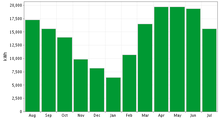Solar data logger
Solar data loggers are used to monitor and log the performance of photovoltaic systems .

A photovoltaic system usually has numerous inverters that convert the direct current from the solar modules into alternating current. Depending on the solar radiation, a certain amount of energy is fed into the power grid.
A solar data logger monitors the power that each individual inverter emits into the power grid and records this. A daily report on the yield of the solar power system can be created from the measured values. The log data can also be used for monthly or annual evaluations. The data logger is connected to the inverter (s) of the solar power system via RS485 interface or Bluetooth . The control of the performance data of the PV system, the monitoring of the inverters as well as the yield forecast and degradation calculation (age-related decrease in efficiency) are usually carried out online and can thus be accessed via the Internet via personal computer (PC) or mobile phone . By comparing it with reference data, the data logger can quickly draw attention to faults in the inverter.
Today, an internal data logger is the standard that many inverter manufacturers already offer. These have the advantage that there are no additional costs for storing the system data. Internal data loggers usually offer various interfaces that enable the user to send the data to a solar portal or the home PC via a DSL connection or a GSM / analog modem.
Recently, an LC display system can also be used to visualize the yield data. For this purpose, the data is recorded by a data logger and transmitted to an LC display or shown directly on the display of the data logger. In this way, the observer can read the values in the form of performance diagrams or bar charts.